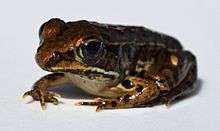Southern leopard frog
| Southern leopard frog | |
|---|---|
 | |
| Scientific classification | |
| Kingdom: | Animalia |
| Phylum: | Chordata |
| Subphylum: | Vertebrata |
| Class: | Amphibia |
| Order: | Anura |
| Family: | Ranidae |
| Genus: | Lithobates |
| Species: | L. sphenocephalus |
| Binomial name | |
| Lithobates sphenocephalus (Cope, 1889) | |
| Synonyms | |
The southern leopard frog (Lithobates sphenocephalus[1][3] or Rana sphenocephala[4][5]) is a species of true frog. It is native to the eastern United States from Kansas to New York to Florida. It is also an introduced species in some areas.[1]
Description
This frog is up to 13 centimeters long. It is green or brown in color with a yellowish ridge along each side of the back. There are rounded dark spots on the back and sides. There is a light spot on each eardrum. The male has larger forelimbs than the female. The breeding male has vocal sacs that are spherical when inflated. The call is described as a "ratchetlike trill",[6] "chuckling croak",[7] or a "squeaky balloon-like sound".[8]
The larva is mottled, and the eyes are positioned on the top of the head. It grows to 7.6 centimeters in length before maturing. The female lays an egg mass that is "baseball-sized" when close to hatching time, and contains up to 1500 eggs.[6]
Ecology and behavior
This frog lives in many types of shallow freshwater habitat and sometimes slightly brackish water. It is usually found close to water but it can stay on dry land for long periods of time.[7] During warmer months it moves away from the water for most of the time.[9] It is mostly nocturnal,[9] but it can be active during the day and the night, especially during rainfall. It breeds in the winter and spring, and sometimes in the fall; heavy periods of rainfall trigger breeding.[7] The egg mass is connected to aquatic vegetation.[8] It may nest communally.[9] Eggs hatch in 4 days to nearly two weeks.[9] The tadpoles take 50 to 75 days to develop to adulthood.[9]
In northern parts of its range it is dormant during the winter months, during which time it remains in well-oxygenated, unfrozen water bodies.[9]
Range
This frog is widespread across the eastern United States, especially the southeast. It is the most common frog in Florida and in several other regions. It is an introduced species in the Bahamas.[1] There was also an introduced population in Southern California at Prado Flood Control Basin that has disappeared.[9]
Subspecies
There are two subspecies:[9]
- Lithobates sphenocephala sphenocephala – Florida Leopard Frog
- Lithobates sphenocephala utricularia – Southern Leopard Frog
Gallery
- A metamorph
- Egg mass
References
| Wikispecies has information related to: Rana sphenocephala |
| Wikimedia Commons has media related to Southern leopard frog. |
- 1 2 3 4 IUCN SSC Amphibian Specialist Group. 2014. Lithobates sphenocephalus. The IUCN Red List of Threatened Species 2014. Downloaded on 16 June 2016.
- ↑ Stejneger, L.H. and T. Barbour. (1917). A Check List of North American Amphibians and Reptiles. Harvard University Press. Cambridge, Massachusetts. p. 39
- ↑ Frost, D.-R.; et al. (2009). "Response to the Point Of View of Gregory B. Pauly, David M. Hillis, and David C. Cannatella, by the Anuran Subcommittee of the SSRA/HL/ASIH Scientific and Standard English Names List". Herpetologica. 65 (2): 136–153. doi:10.1655/09-009R1.1.
- ↑ Hillis & Wilcox (2005), Hillis (2007), Stuart (2008), Pauly et al. (2009), AmphibiaWeb (2016)
- ↑ Yuan, Z.-Y.; et al. (2016). "Spatiotemporal diversification of the true frogs (genus Rana): A historical framework for a widely studied group of model organisms.". Systematic Biology. 65: syw055. PMID 27288482. doi:10.1093/sysbio/syw055.
- 1 2 NatureServe. 2015. Lithobates sphenocephalus. NatureServe Explorer Version 7.1. Accessed 15 June 2016.
- 1 2 3 Norman, C. Southern Leopard Frog (Rana (Lithobates) sphenocephala). Savannah River Ecology Laboratory. University of Georgia.
- 1 2 Southern Leopard Frog (Lithobates sphenocephalus). Department of Wildlife Ecology and Conservation. University of Florida.
- 1 2 3 4 5 6 7 8 Lithobates sphenocephalus – Southern Leopard Frog. California Herps.
Further reading
- AmphibiaWeb, available at http://amphibiaweb.org/
- Cope, E. D. (1886). "Synonymic list of the North American species of Bufo and Rana, with descriptions of some new species of Batrachia, from specimens in the National Museum". Proceedings of the American Philosophical Society. 23 (124): 514–26.
- Hillis DM. (1988). "Systematics of the Rana pipiens Complex: Puzzle and Paradigm". Annual Review of Ecology and Systematics. 19: 39–63. JSTOR 2097147. doi:10.1146/annurev.es.19.110188.000351.
- Hillis, D. M. (2007). "Constraints in naming parts of the Tree of Life" (PDF). Mol. Phylogenet. Evol. 42: 331–338. PMID 16997582. doi:10.1016/j.ympev.2006.08.001.
- Hillis, David M.; Frost, John S.; Wright, David A. (1983). "Phylogeny and Biogeography of the Rana pipiens Complex: A Biochemical Evaluation". Systematic Zoology. 32 (2): 132–43. JSTOR 2413277. doi:10.1093/sysbio/32.2.132.
- Hillis, D. M.; Wilcox, T. P. (2005). "Phylogeny of the New World true frogs (Rana)" (PDF). Mol. Phylogenet. Evol. 34 (2): 299–314. PMID 15619443. doi:10.1016/j.ympev.2004.10.007.
- Newman, C. E.; Rissler, L. J. (2011). "Phylogeographic analyses of the southern leopard frog: the impact of geography and climate on the distribution of genetic lineages vs. subspecies". Molecular Ecology. 20 (24): 5295–5312. PMID 22066968. doi:10.1111/j.1365-294X.2011.05353.x.
- Pauly, Greg B.; Hillis, David M.; Cannatella, David C. (2009). "Taxonomic freedom and the role of official lists of species names" (PDF). Herpetologica. 65: 115–128. doi:10.1655/08-031r1.1.
- Stuart, Bryan L (2008). "The phylogenetic problem of Huia (Amphibia: Ranidae)". Mol. Phylogenet. Evol. 46 (1): 49–60. PMID 18042407. doi:10.1016/j.ympev.2007.09.016.
- Yuan, Z.-Y.; Zhou, W.-W.; Chen, X.; Poyarkov, N. A.; Chen, H.-M.; Jang-Liaw, N.-H.; Chou, W.-H.; Iizuka, K.; Min, M.-S.; Kuzmin, S. L.; Zhang, Y.-P.; Cannatella, D. C.; Hillis, D. M.; Che, J. (2016). "Spatiotemporal diversification of the true frogs (genus Rana): A historical framework for a widely studied group of model organisms". Systematic Biology. 65: syw055. PMID 27288482. doi:10.1093/sysbio/syw055.
